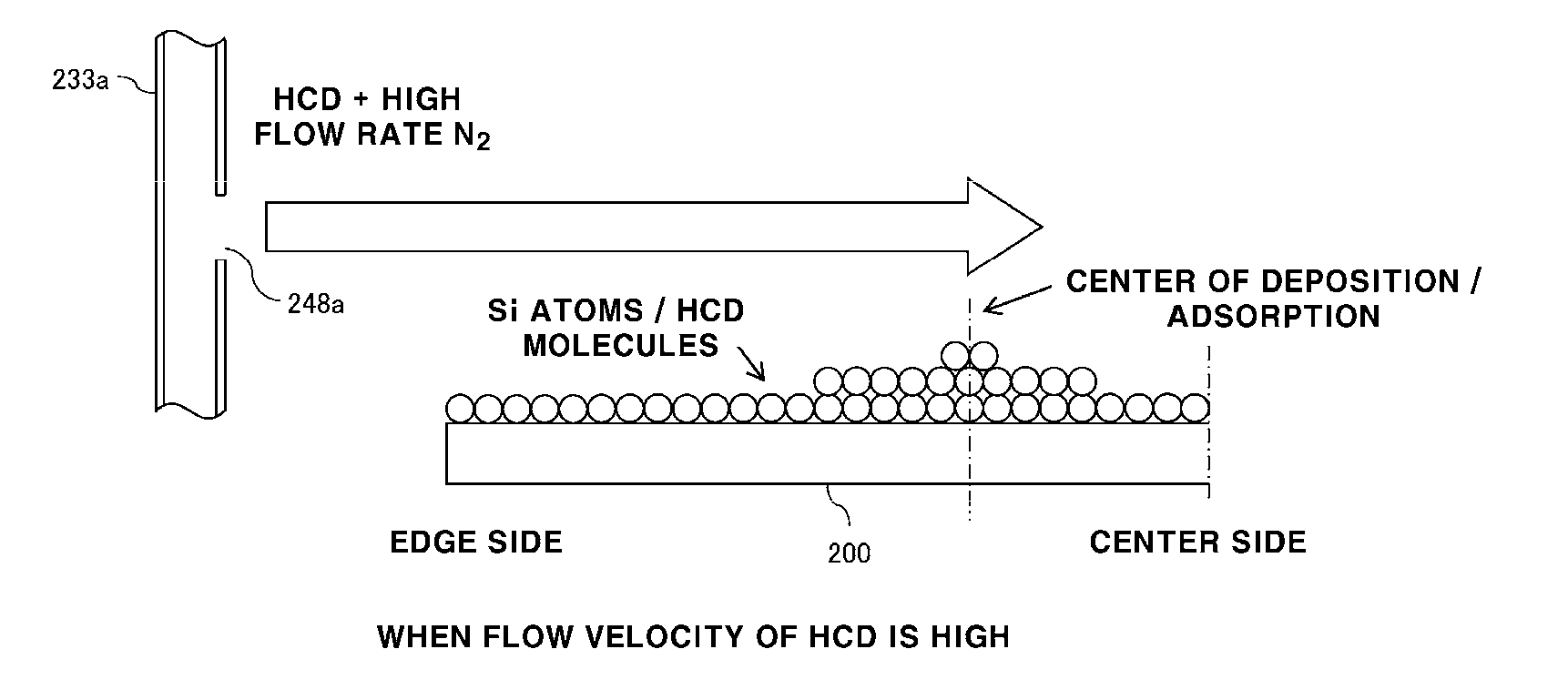Method of manufacturing semiconductor device, method of processing substrate, and substrate processing apparatus
a semiconductor and substrate technology, applied in the direction of liquid surface applicators, coatings, chemical vapor deposition coatings, etc., can solve the problems of difficult to reduce hydrogen, difficult to apply the temperature increasing method to production, and high stress of the sin film formed by the cvd method, etc., to achieve good uniformity of film thickness and low hydrogen concentration.
- Summary
- Abstract
- Description
- Claims
- Application Information
AI Technical Summary
Benefits of technology
Problems solved by technology
Method used
Image
Examples
first example
[0102]Next, a first example will be described.
[0103]SiN films were formed on wafers according to the film-forming sequence of the current embodiment, and film thicknesses and thickness uniformities in surfaces of the wafers were measured. The film-forming temperature (wafer temperature) was set to 800° C. to 950° C., which is known as the thickness at which uniformities are noticeably deteriorated. The supply flow rate of N2 gas which is a deposition / adsorption inhibition gas was changed into three kinds of flow rates between 2 and 8 slm. The three kinds of supply flow rates of N2 gas became (A) 2.5, (B) 5.0 and (C) 7.5 when a certain flow rate was set as 1, which are hereinafter referred to as flow rate conditions (A), flow rate conditions (B) and flow rate conditions (C). The other film forming conditions (processing conditions in each step) were in the processing condition range described in the above embodiment. The results are shown in FIGS. 6 and 7.
[0104]FIG. 6 is a view illus...
second example
[0108]Next, a second example will be described.
[0109]SiN films were formed on wafers according to the film-forming sequence of the embodiment, and hydrogen concentration and film density of the SiN films were measured. The film-forming temperature (wafer temperature) was changed into three kinds of temperatures in the range of 600° C. to 900° C. The supply flow rate of N2 gas which is a deposition / adsorption inhibition gas was set to a flow rate within the range of 2 slm to 8 slm. Other film forming conditions (processing conditions at each step) were set to conditions in the processing conditions described in the above embodiment. In addition, the hydrogen concentration of SiN films was measured by thermal desorption spectroscopy (TDS), and the film density was measured by X-ray reflection (XRR). The results are shown in FIGS. 8 and 9.
[0110]FIG. 8 is a view illustrating a relationship between a film forming temperature of the SiN film and a hydrogen concentration (an amount of hydr...
third example
[0114]Next, a third example will be described.
[0115]SiN films were formed on wafers using a film-forming sequence of the embodiment where a deposition / adsorption inhibition gas was used and a film forming sequence of the embodiment where the deposition / adsorption inhibition gas was not used, and within-wafer thickness uniformities of the SiN films were respectively measured. The film forming temperatures in the film forming sequence of the embodiment where the deposition / adsorption inhibition gas was used were changed between 800° C. and 900° C. The film forming temperatures in the film forming sequence of the embodiment where the deposition / adsorption inhibition gas was not used were changed between 600° C. and 900° C. Other film forming conditions (processing conditions in each step) were set in the conditions described in the embodiment.
[0116]The results are shown in FIG. 11. FIG. 11 illustrates a relationship between the within-wafer thickness uniformity and the film-forming tem...
PUM
| Property | Measurement | Unit |
|---|---|---|
| temperature | aaaaa | aaaaa |
| temperature | aaaaa | aaaaa |
| temperature | aaaaa | aaaaa |
Abstract
Description
Claims
Application Information
 Login to View More
Login to View More - R&D
- Intellectual Property
- Life Sciences
- Materials
- Tech Scout
- Unparalleled Data Quality
- Higher Quality Content
- 60% Fewer Hallucinations
Browse by: Latest US Patents, China's latest patents, Technical Efficacy Thesaurus, Application Domain, Technology Topic, Popular Technical Reports.
© 2025 PatSnap. All rights reserved.Legal|Privacy policy|Modern Slavery Act Transparency Statement|Sitemap|About US| Contact US: help@patsnap.com



